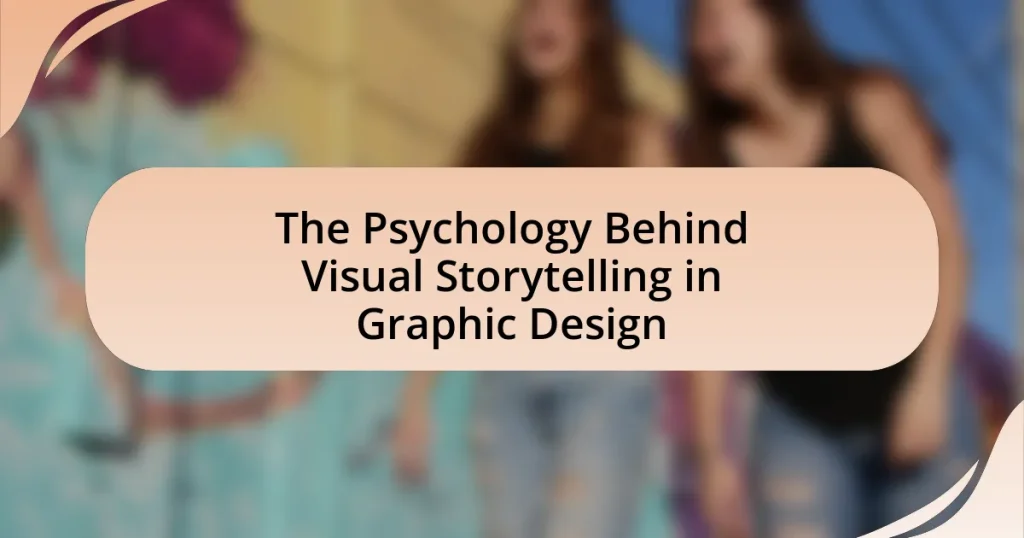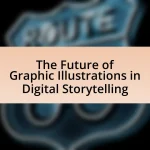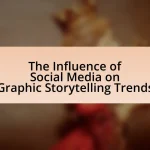The article explores the psychology behind visual storytelling in graphic design, emphasizing how visual elements such as color, composition, and imagery influence audience perception and emotional responses. It highlights the effectiveness of visuals in communication, noting that they are processed significantly faster than text and enhance memory retention. Key psychological principles, including Gestalt principles and cognitive load theory, are discussed, along with the impact of colors and shapes on emotions. The article also addresses the importance of narrative in engaging viewers, enhancing brand identity, and providing best practices for combining visuals and text to create compelling stories in various design mediums.
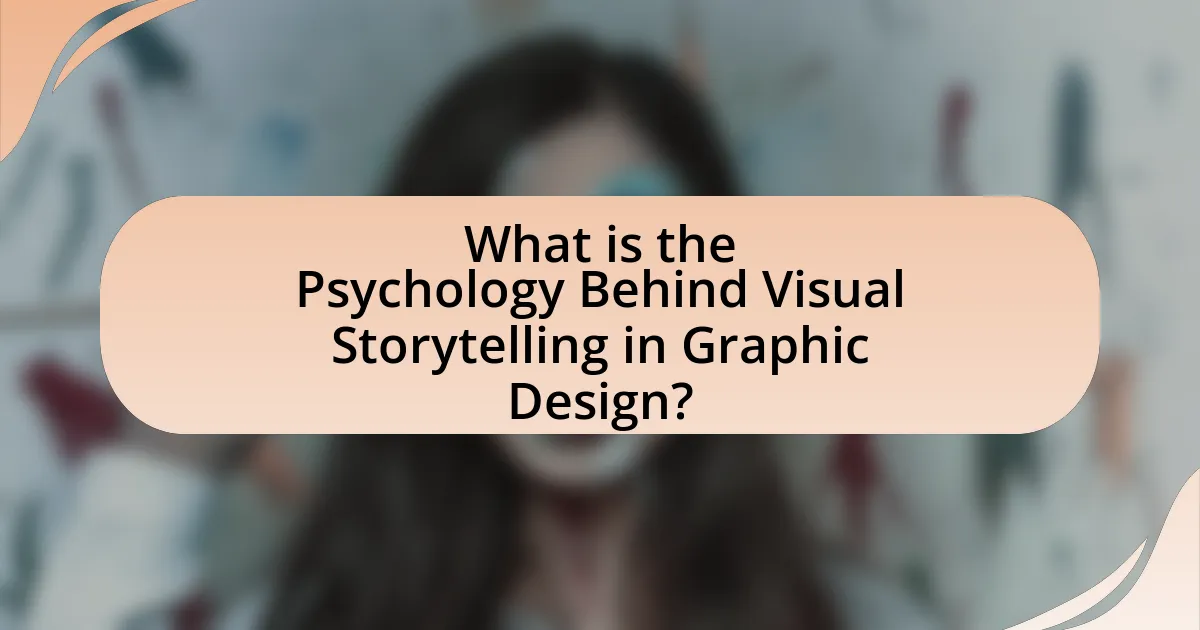
What is the Psychology Behind Visual Storytelling in Graphic Design?
The psychology behind visual storytelling in graphic design centers on how visuals influence perception and emotional response. Visual elements, such as color, composition, and imagery, evoke specific feelings and associations, guiding the audience’s understanding and engagement with the message. Research indicates that visuals are processed 60,000 times faster than text, highlighting their effectiveness in communication. Additionally, studies show that people retain 65% of information when paired with relevant visuals, compared to only 10% when presented with text alone. This demonstrates that effective visual storytelling can enhance memory retention and emotional connection, making it a powerful tool in graphic design.
How does visual storytelling influence audience perception?
Visual storytelling significantly influences audience perception by engaging emotions and enhancing memory retention. Research indicates that visuals are processed 60,000 times faster than text, allowing audiences to grasp complex narratives quickly. This rapid processing fosters emotional connections, as images can evoke feelings more effectively than words alone. For instance, a study published in the journal “Cognitive Science” by Paul Ekman demonstrates that facial expressions in visual storytelling can elicit empathy and understanding, shaping how audiences interpret a narrative. Consequently, effective visual storytelling not only captures attention but also shapes the audience’s emotional and cognitive responses, leading to a deeper understanding of the message conveyed.
What psychological principles are at play in visual storytelling?
Visual storytelling employs several psychological principles, including the Gestalt principles, emotional engagement, and cognitive load theory. The Gestalt principles, such as proximity and similarity, help viewers organize visual information into coherent groups, enhancing comprehension. Emotional engagement is crucial, as narratives that evoke feelings can lead to stronger connections and retention of information; studies show that emotionally charged stories are remembered more vividly. Cognitive load theory suggests that simplifying visual elements can improve understanding and retention, as excessive information can overwhelm the viewer. These principles collectively enhance the effectiveness of visual storytelling in graphic design.
How do colors and shapes affect emotional responses?
Colors and shapes significantly influence emotional responses by evoking specific feelings and associations. For instance, warm colors like red and yellow can generate feelings of warmth, excitement, or urgency, while cool colors such as blue and green often promote calmness and tranquility. Research by Andrew Elliot and Markus Maier in their study “Color and Psychological Functioning: The Effect of Red on Performance Attainment” published in 2014 demonstrates that red can enhance attention and increase performance in tasks requiring focus. Similarly, shapes also play a crucial role; rounded shapes tend to evoke feelings of softness and comfort, while sharp angles can create a sense of tension or aggression. This interplay between colors and shapes is essential in graphic design, as it helps convey the intended emotional narrative effectively.
Why is visual storytelling important in graphic design?
Visual storytelling is important in graphic design because it effectively communicates messages and engages audiences on an emotional level. This approach leverages visual elements such as images, colors, and typography to create narratives that resonate with viewers, making complex information more accessible and memorable. Research indicates that visuals can increase information retention by up to 65% compared to text alone, highlighting the power of imagery in conveying ideas. Furthermore, effective visual storytelling can enhance brand identity and foster a deeper connection with the audience, ultimately driving engagement and influencing consumer behavior.
What role does narrative play in engaging viewers?
Narrative plays a crucial role in engaging viewers by creating an emotional connection and facilitating understanding of the content. When a narrative is present, it guides viewers through a structured experience, making complex information more relatable and memorable. Research indicates that stories activate the brain’s mirror neurons, which enhance empathy and engagement, as demonstrated in a study by Paul Zak, published in the journal “PLOS ONE,” where narratives increased oxytocin levels, fostering a sense of connection. This emotional engagement leads to higher retention and a more profound impact on the audience, reinforcing the importance of narrative in visual storytelling within graphic design.
How can visual storytelling enhance brand identity?
Visual storytelling enhances brand identity by creating a memorable and emotional connection with the audience. This technique utilizes images, videos, and graphics to convey a brand’s values, mission, and personality, making it easier for consumers to relate to and remember the brand. Research indicates that visuals are processed 60,000 times faster than text, which means that effective visual storytelling can significantly improve brand recall and recognition. For instance, brands like Coca-Cola and Apple have successfully employed visual narratives to reinforce their identities, leading to increased customer loyalty and engagement.
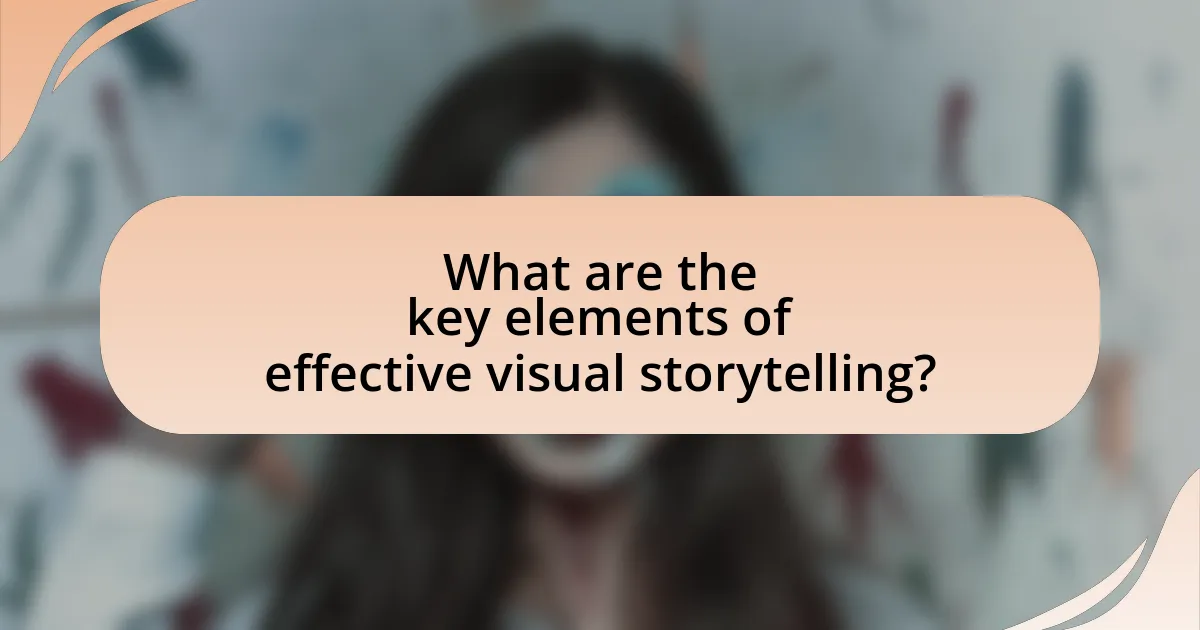
What are the key elements of effective visual storytelling?
The key elements of effective visual storytelling include clarity, emotional engagement, and a cohesive narrative structure. Clarity ensures that the message is easily understood, allowing the audience to grasp the core idea without confusion. Emotional engagement captures the audience’s attention and fosters a connection, often achieved through relatable characters or compelling visuals. A cohesive narrative structure organizes the story logically, guiding the viewer through the visual elements in a way that enhances comprehension and retention. Research indicates that stories with these elements are more memorable; for instance, a study by Paul Zak found that narratives that evoke emotions can increase information retention by up to 65%.
How do images and text work together in storytelling?
Images and text work together in storytelling by creating a cohesive narrative that enhances understanding and emotional engagement. The combination allows visual elements to complement and reinforce the written word, making complex ideas more accessible. For instance, studies show that visuals can improve information retention by up to 65% when paired with relevant text, as they provide context and stimulate emotional responses. This synergy between images and text not only captures attention but also guides the audience through the narrative, ensuring a more immersive experience.
What are the best practices for combining visuals and text?
The best practices for combining visuals and text include ensuring clarity, maintaining visual hierarchy, and enhancing engagement. Clarity is achieved by using legible fonts and contrasting colors that make text easy to read against the background. Visual hierarchy can be established through size, color, and placement, guiding the viewer’s attention to the most important elements first. Enhancing engagement involves using visuals that complement the text, such as relevant images or infographics that reinforce the message, thereby improving retention and understanding. Research indicates that visuals can increase information retention by up to 65% when paired with text, highlighting the effectiveness of this approach in communication.
How does layout impact the flow of a visual story?
Layout significantly impacts the flow of a visual story by guiding the viewer’s eye and establishing a narrative sequence. A well-structured layout utilizes elements such as hierarchy, spacing, and alignment to create a coherent path for the viewer to follow, which enhances comprehension and engagement. For instance, studies in graphic design indicate that layouts with clear focal points and logical progression lead to better retention of information, as they facilitate easier navigation through the content. This is supported by research from the Nielsen Norman Group, which highlights that users are more likely to remember information presented in a visually organized manner compared to cluttered or chaotic designs.
What techniques can be used to evoke emotions through design?
Techniques to evoke emotions through design include color theory, typography, imagery, and layout. Color theory utilizes specific colors to elicit emotional responses; for example, blue often conveys calmness, while red can evoke excitement or urgency. Typography influences perception through font choice; serif fonts may suggest tradition and reliability, while sans-serif fonts can appear modern and approachable. Imagery, including photographs and illustrations, can create connections by depicting relatable scenarios or emotions. Layout affects how information is processed; a balanced composition can instill harmony, while asymmetry can create tension or dynamism. Research by the American Psychological Association indicates that color can significantly impact mood and behavior, reinforcing the effectiveness of these techniques in design.
How can storytelling techniques be applied to different design mediums?
Storytelling techniques can be applied to different design mediums by utilizing narrative structures, character development, and emotional engagement to convey messages effectively. In graphic design, for instance, visual elements such as color, typography, and imagery can be orchestrated to create a cohesive narrative that resonates with the audience. Research indicates that designs incorporating storytelling elements can enhance user engagement and retention, as evidenced by a study published in the Journal of Visual Communication, which found that narratives in visual content increase information recall by up to 65%. Similarly, in web design, storytelling can guide user experience through intuitive navigation and compelling content that leads users through a journey, fostering a deeper connection with the brand. In product design, storytelling can be reflected in the product’s aesthetics and functionality, creating a narrative that aligns with the user’s values and experiences. Thus, storytelling techniques are versatile and can significantly enhance the impact of various design mediums.
What are the common pitfalls to avoid in visual storytelling?
Common pitfalls to avoid in visual storytelling include overloading visuals with information, neglecting the audience’s perspective, and failing to create a cohesive narrative. Overloading visuals can confuse viewers, as studies show that too much information can lead to cognitive overload, reducing comprehension. Neglecting the audience’s perspective may result in a disconnect between the message and the viewer’s interpretation, as effective storytelling requires understanding the audience’s context and needs. Lastly, failing to create a cohesive narrative can lead to disjointed visuals that do not effectively communicate the intended message, as a clear narrative structure is essential for guiding the viewer through the story.
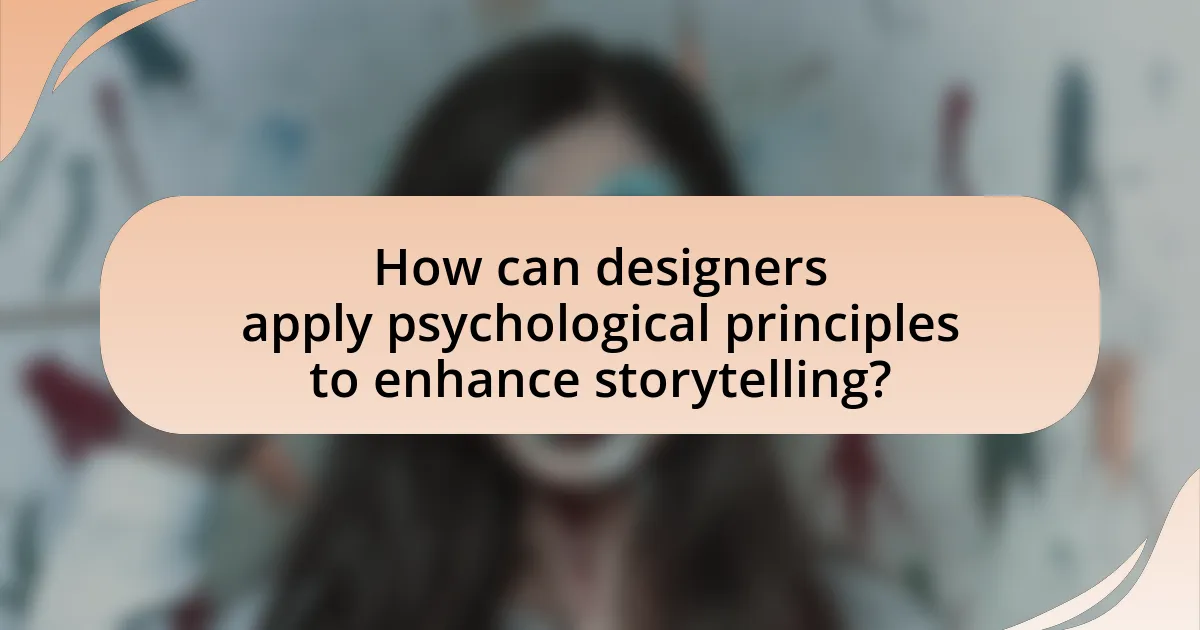
How can designers apply psychological principles to enhance storytelling?
Designers can apply psychological principles to enhance storytelling by utilizing concepts such as cognitive load, emotional engagement, and visual hierarchy. Cognitive load theory suggests that simplifying information presentation allows audiences to process narratives more effectively, leading to better retention and understanding. Emotional engagement can be achieved through color psychology, where specific colors evoke particular feelings, thus influencing the audience’s emotional response to the story. Visual hierarchy, established through size, contrast, and placement, guides viewers’ attention and emphasizes key narrative elements, ensuring that the most important aspects of the story are highlighted. Research indicates that narratives incorporating these principles result in a more compelling and memorable experience for the audience, as evidenced by studies showing that emotionally charged stories are more likely to be remembered than neutral ones.
What strategies can be used to create compelling narratives?
To create compelling narratives, one effective strategy is to employ a clear structure that includes a beginning, middle, and end, which helps guide the audience through the story. This structure is supported by the narrative arc, which consists of exposition, rising action, climax, falling action, and resolution, allowing for emotional engagement and tension build-up. Research indicates that stories following this arc are more memorable and impactful, as they align with human cognitive patterns for processing information (Bruner, 1991). Additionally, incorporating relatable characters and conflicts enhances audience connection, making the narrative more engaging. Studies show that narratives featuring well-developed characters can increase empathy and investment in the story (Green & Brock, 2000). Using vivid imagery and sensory details also strengthens the narrative by creating immersive experiences, which can lead to better retention and emotional responses from the audience.
How can understanding audience psychology improve design choices?
Understanding audience psychology can significantly enhance design choices by ensuring that visual elements resonate with the target demographic. When designers comprehend the motivations, preferences, and emotional triggers of their audience, they can create visuals that effectively communicate messages and evoke desired responses. For instance, research indicates that color psychology plays a crucial role in influencing perceptions; blue often conveys trust, while red can evoke excitement. By leveraging these insights, designers can tailor their work to align with audience expectations and enhance engagement, ultimately leading to more effective communication and improved user experience.
What role does empathy play in visual storytelling?
Empathy is crucial in visual storytelling as it enables creators to connect emotionally with their audience. By understanding and reflecting the feelings and experiences of viewers, visual storytellers can craft narratives that resonate on a deeper level. Research indicates that stories evoking empathy can enhance engagement and retention; for instance, a study published in the journal “Psychological Science” found that narratives that elicit empathy lead to increased prosocial behavior among audiences. This connection fosters a more immersive experience, allowing viewers to relate personally to the characters and situations depicted, ultimately enhancing the overall impact of the visual narrative.
What tools and resources are available for graphic designers?
Graphic designers have access to a variety of tools and resources that enhance their creative process and efficiency. Key software includes Adobe Creative Suite (Photoshop, Illustrator, InDesign), which is widely regarded as industry standard for graphic design tasks. Additionally, tools like Sketch and Figma are popular for UI/UX design, allowing for collaborative work and prototyping. Resources such as online platforms like Canva provide templates and design elements for quick projects, while websites like Behance and Dribbble serve as inspiration and networking hubs for designers. Furthermore, educational resources, including online courses from platforms like Skillshare and Coursera, offer training in design principles and software skills. These tools and resources collectively support graphic designers in creating visually compelling narratives.
How can designers leverage technology to enhance storytelling?
Designers can leverage technology to enhance storytelling by utilizing interactive media, augmented reality (AR), and data visualization tools. Interactive media allows audiences to engage with narratives actively, fostering a deeper emotional connection. For instance, AR can overlay digital elements onto the physical world, creating immersive experiences that enhance the storytelling process. Data visualization tools enable designers to present complex information in a visually compelling manner, making narratives more accessible and impactful. Research shows that interactive storytelling can increase user retention by up to 70%, demonstrating the effectiveness of these technological approaches in enhancing narrative engagement.
What are some recommended software and platforms for visual storytelling?
Some recommended software and platforms for visual storytelling include Adobe Creative Cloud, Canva, and Prezi. Adobe Creative Cloud offers a comprehensive suite of tools like Photoshop and Illustrator, which are essential for creating high-quality graphics and visual narratives. Canva provides an accessible platform for users to design visually appealing content with its user-friendly interface and extensive template library. Prezi stands out for its dynamic presentation capabilities, allowing users to create engaging, non-linear storytelling experiences. These platforms are widely used in the industry, demonstrating their effectiveness in enhancing visual storytelling.
What are best practices for implementing visual storytelling in projects?
Best practices for implementing visual storytelling in projects include defining a clear narrative, utilizing strong visuals, and ensuring audience engagement. A clear narrative provides a structured storyline that guides the viewer through the content, making it easier to understand and remember. Strong visuals, such as high-quality images and graphics, enhance the emotional impact and help convey complex ideas quickly. Engaging the audience through interactive elements or relatable characters fosters a deeper connection and encourages retention of the message. Research indicates that visuals can increase information retention by up to 65%, highlighting the effectiveness of these practices in enhancing communication and understanding in graphic design projects.
